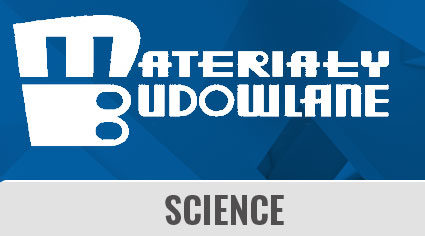Forma architektoniczna a efektywność konstrukcji łukowych z drewna klejonego
(Open Access)
DOI: 10.15199/33.2025.05.07
citation/cytuj: Wiercińska M., Dzun M. Architectural form and structural efficiency of arched glued-laminated timber structures. Materiały Budowlane. 2025. Volume 633. Issue 05. Pages 50-57. DOI: 10.15199/33.2025.05.07
- Abstract / Streszczenie
- Keywords / Słowa kluczowe
- Literature
- Afiliation
- Corresponding Author
- Open Access
Contemporary architecture integrates traditional materials withmodern technologies, and glued-laminated timber is playing an increasingly significant role in large-scale structures. This study compares the stress distribution in three arches of identical span, designed using two different methods. The first method involves determining the geometric axis of the arch through a graphical approach based on the force triangle. The second method assumes the arch axis as a circular segment. The results indicate that arches designed using the force triangle method exhibit a more uniform stress distribution. This finding highlights the potential of this method for further research on material optimization in relation to cross-sectional variability.
Współczesna architektura łączy tradycyjne materiały z nowoczesnymi technologiami, a drewno klejone odgrywa coraz większą rolę w dużych konstrukcjach. W artykule porównano rozkład naprężeń w trzech łukach o tej samej rozpiętości, ukształtowanych wg dwóch metod projektowania. Pierwsza z nich to wykreślanie osi geometrycznej łuku z użyciem graficznej metody wykorzystującej trójkąt sił, natomiast druga polega na przyjęciu osi łuku jako wycinka okręgu. Wyniki wskazują, że łuki wykreślone metodą trójkąta sił mają bardziej równomierny rozkład naprężeń, co oznacza potencjał metody do dalszych badań nad optymalizacją materiałową w związku ze zmiennością przekrojów.
Współczesna architektura łączy tradycyjne materiały z nowoczesnymi technologiami, a drewno klejone odgrywa coraz większą rolę w dużych konstrukcjach. W artykule porównano rozkład naprężeń w trzech łukach o tej samej rozpiętości, ukształtowanych wg dwóch metod projektowania. Pierwsza z nich to wykreślanie osi geometrycznej łuku z użyciem graficznej metody wykorzystującej trójkąt sił, natomiast druga polega na przyjęciu osi łuku jako wycinka okręgu. Wyniki wskazują, że łuki wykreślone metodą trójkąta sił mają bardziej równomierny rozkład naprężeń, co oznacza potencjał metody do dalszych badań nad optymalizacją materiałową w związku ze zmiennością przekrojów.
glued-laminated timber; arches; shape optimization.
drewno klejone; łuki; optymalizacja formy.
drewno klejone; łuki; optymalizacja formy.
- Szewczyk J. Drewno we współczesnej architekturze Część 1.Wstęp do architektury drewnianej. Builder. 2019; 265 (8): 28 – 32.
- Hennessy R, Harris R. The Winter Gardens, Sheffield, UK.World Conf Timber Eng. 2004.
- https://www.prsarchitects.com/projects/arts-civic/sheffield-winter-garden.
- https://rshp.com/projects/culture-and-leisure/bodegas-protos/.
- Gonzalo PalomarG. Control deGestión. Cuadro deMando Integral para la Bodega Protos. 2016.
- Martínez Cordón D. Traducción comentada ES>FR de parte de la página web de las Bodegas Protos de Peñafiel. 2022.
- Bowen DH, Greene JP, Kisida B. Learning to think critically: A visual art experiment. Educ Res. 2014; 43 (1): 37 – 44.
- https://www.enr.com/articles/56522-contractors-take-care-in-expanding-arkansas- art-museum.
- Dickson M, Parker D. Sustainable Timber Design. Oxford: Routledge; 2014.
- Vranovci K. The Effects of Crystal Bridges in Downtown Revitalization of Bentonville, Arkansas in The Last Decade. Fayetteville, AR: University of Arkansas; 2018.
- Burry J, et al. Fabricate 2020. London: UCL Press; 2020.
- Kamionka L, Wdowiak-Postulak A, Hajdenrajch A. Nowoczesne budownictwo drewniane w technologii CLT na przykładzie budynku Bioklimatycznej Jednostki Modularnej. MateriałyBudowlane. 2022; https://doi. org/10.15199/33.2022.03.07.
- Issa CA, Kmeid Z. Advanced wood engineering: glulambeams. Constr Build Mater. 2005; 19 (2): 99 – 106.
- Haddadi R. An Industry in Transition: Early Glue-Laminated Timber in Switzerland, 1909-1939. Zurich: ETH Zurich; 2023.
- Szewczyk J. Drewno we współczesnej architekturze Część 2. Budownictwo szybkościowe z drewna. Builder. 2019; 266 (9): 32 – 36.
- Moody RC, Hernandez R. Glued-laminated timber. Madison: Forest Product Laboratory, USDH Forest Service; 1997.
- Kram D, Nowak K, Śliwa-Wieczorek K, Hrehorowicz-Gaber H, Błazy R, Hrehorowicz- Nowak A, Błachut J, Łysień M, Ciepiela A, Dudek J. Drewniane budownictwo modułowe jako innowacyjne rozwiązanie szkół przyszłości. Materiały Budowlane. 2023; https://doi. org/10.15199/33.2023.12.06.
- Nowak T. Wpływ smukłości przekrojów zginanych elementów z drewna klejonego warstwowo na nośność w warunkach pożaru. Materiały Budowlane. 2015; 1: 52 – 55.
- Aicher S, Stapf G. Block glued glulam – Bridges, beams and arches. In: Proceedings of the World Conference on Timber Engineering (WCTE 2014). Quebec City, Canada; 2014.
- Stefanska A, Cygan M, Batte K, Pietrzak J. Applications of timber and wood- basedmaterials in architectural design usingmulti-objective optimisation tools. ConstrEconBuild. 2021; https://doi.org/10.5130/AJCEB. v21i3.7606.
- Wiercińska M. Potencjał oszczędności materiału w łukach pracujących na ściskanie, a forma architektoniczna. Optymalizacja zużycia materiału na etapie projektowania wstępnego konstrukcji. Przegląd Budowlany. 2025; 3.
- Średniawa W. Zastosowanie konstrukcji z drewna klejonego w budownictwie ogólnymi mostownictwie. Kraków: Wydawnictwo Politechniki Krakowskiej; 2021.
- Premrov M, Žegarac, Leskovar V. Innovative structural systems for timber buildings: Acomprehensivereviewofcontemporarysolutions.Buildings.2023;13(7):1820.
- Ong C. B. Glue-laminated timber (Glulam). In: Wood Composites. 1st ed. 2015. p. 123–140.
- Szeptyński P, Jasińska D, Mikulski L. Shape optimization and experimental investigation of glue-laminated timber beams. Materials. 2024; https://doi.org/10.3390/ma17246263.
- Kukule A, Rocens K. Reduction of wood consumption for glulam arch by its strengthening. In: Proceedings of the International Scientific Conference „Innovative Materials, Structures and Technologies”. 2014. p. 69–76.
mgr inż. arch. Milena Wiercińska, Politechnika Białostocka, Wydział Architektury
ORCID: 0000-0003-3354-9780
mgr inż. Michał Dzun, Politechnika Białostocka, Wydział Budownictwa i Nauk o Środowisku
ORCID: 0000-0003-2478-5538
ORCID: 0000-0003-3354-9780
mgr inż. Michał Dzun, Politechnika Białostocka, Wydział Budownictwa i Nauk o Środowisku
ORCID: 0000-0003-2478-5538
mgr inż. arch. Milena Wiercińska, Politechnika Białostocka, Wydział Architektury
ORCID: 0000-0003-3354-9780
Correspondence address: m.wiercinska@pb.edu.pl
Received: 16.12.2024 / Artykuł wpłynął do redakcji: 16.12.2024 r.
Revised: 14.02.2025 / Artykuł wpłynął do redakcji: 16.12.2024 r.
Published: 22.05.2025 / Opublikowano: 22.05.2025 r.
